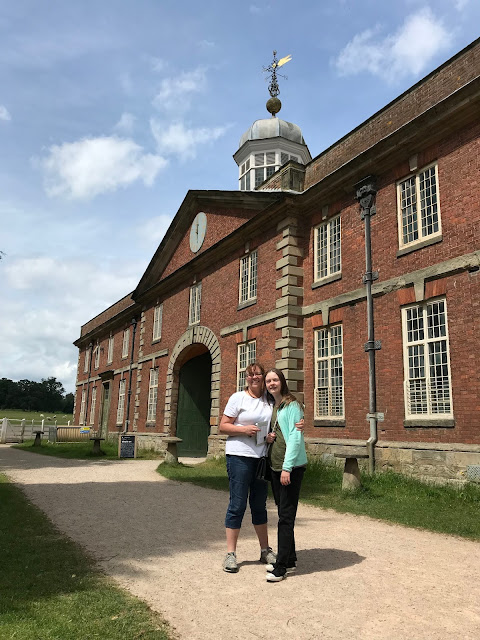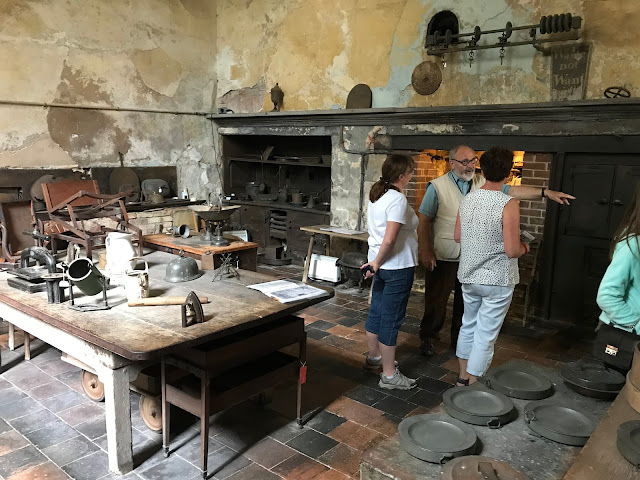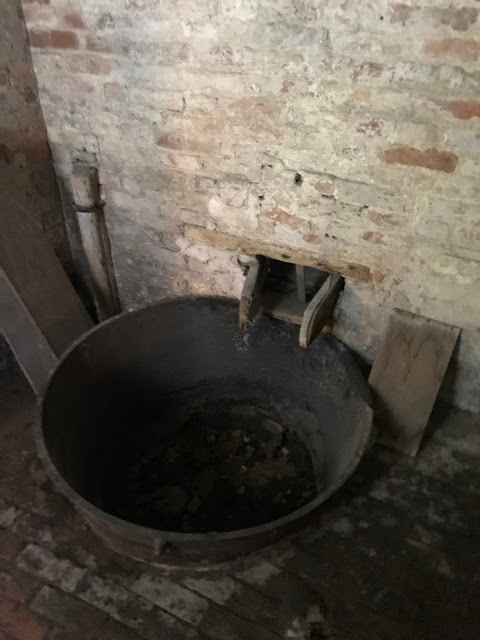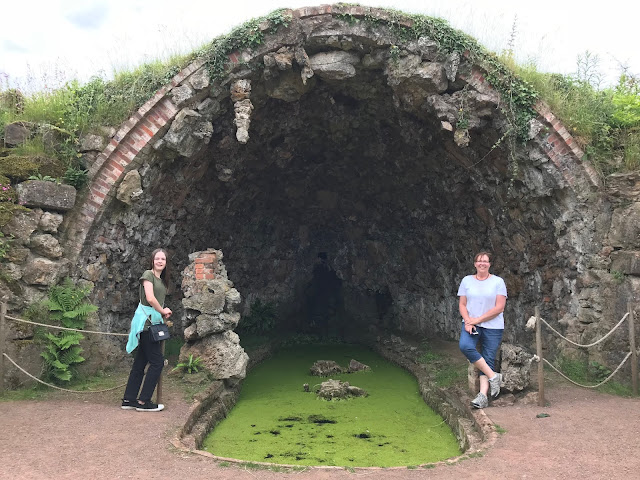June 15, 2018 - Calke Abbey
Today we got to tour Calke Abbey. Wikipedia says the following about it:
The site was an Augustinian priory from the 12th century until its dissolution by Henry VIII. The present building, named Calke Abbey in 1808, was never actually an abbey, but is a Baroque mansion built between 1701 and 1704.
The house was owned by the Harpur family for nearly 300 years until it was passed to the Trust in 1985 in lieu of death duties. Today, the house is open to the public and many of its rooms are deliberately displayed in the state of decline in which the house was handed to the Trust.
We really loved seeing this impressive home, as it was left just as the family had had it when it was turned over to the National Trust (like the UK's National Park Service), and the family apparently rarely threw anything away. It really gave you a sense of what it had been like to live in the house.
As with many of these large halls, Calke Abbey had large (in fact big enough to raise a substantial flock of sheep), beautiful grounds surrounding it. The drive to the house through the massive trees was spectacular!
Before you get to see much of the house, you pass through the impressive stables pictured below.
They still had several carriages and a type of wheelchair and a mini carriage for two small children, that was known to be pulled by a goat.
The blacksmith's shop still had all the tools that would have been used there.
The house, itself, is rather imposing and feels like something right out of a movie. It really must have been something when it was in its prime! The building had many makeovers through the years, as styles changed. The front doors shown below, on the ground level, were once the site of a large set of stairs, with the main entrance being on the second floor.
The rest of the house had clearly been far more grand, but there was quite a bit of stuff in most of the rooms, like the family had been using the rooms much more for storage than for living.
They made Mark wear his backpack on the front so that he would not accidentally knock anything over in the sometimes cluttered rooms.
The family had large collections of many things. There were a lot of rocks and gems, but the thing they collected the most was taxidermy. It seemed like there was hardly a room in the house that did not have MANY stuffed animals or birds in it.
In the formal dining room the table could be expanded to seat 40+ people or collapse to seat 4.
The room pictured in the next few photos had a large billiard table and a beautiful, burled oak piano (and many, many animal and bird bodies). We mentioned to the docent that Hannah would love to play that piano, so she let her. It was awesome! It made the place feel alive again.
In a different room there was the cabinet pictured below. Apparently it opens up to be a piano/organ-like instrument.
Many of the rooms in the house looked like the picture below with old wallpaper and many, diverse items stockpiled in them.
This dollhouse dates back to the 1800s.
We thought the early version of a shower pictured below was interesting.
The toilet was less interesting. It certainly wouldn't have been very interesting to the servants who had to empty it!
The blue, glass bottle below was used as fire protection. If a fire broke out, one would grab this off the wall and throw it into the fire, the glass would break, and the contents (likely baking soda or something similar) would spread out and put out the fire. We think we will stick with fire extinguishers, thanks.
The National Trust found these clothes in a box in one of the rooms. The dark coat and shoes date back to the 1700s.
The bed in the pictures below was the most impressive piece in the house. Apparently, the National Trust found this amazing bed that dates back to the 1700s in absolutely pristine condition, never having been used and still in its original packing boxes in one of the rooms of the house. We included a picture of the sign that tells about it. Wow!
The two pictures below show all the bells used to signal the servants to come and do something. We were amazed at how many of them there were, and we are still unsure how they would tell the difference between them unless they were sitting right there watching them.
The kitchen was in great disrepair, but it was very interesting to see it. In nearly every room of the house there was a National Trust volunteer present to talk about the history of the room and the objects in it. They were extremely knowledgeable and had plenty of interesting things to say. We loved it!
They told us that the large drum pictured below was called the scullery. Apparently, all of the table and kitchen scraps were dumped through a chute in the wall, into the scullery. The scullery maid had to shovel it out and take it outside to the garbage pile. Not a very fun job! We were interested to learn where the term "scullery maid" originated.
The arches pictured below are all that remain of the original priory that was built in the 1100s. The main house is built on top of them.
In order to get food and other supplies into the house, the help had to haul it all through this long tunnel that came under the stables and into the basement of the house. They built the tunnel so that none of the "unsightly" laborers would ever be seen by the family or their guests.
The house had its own brewery as well.
Though the house is in great disrepair, much of the gardens are kept up by volunteers, and they are impressive! We loved the massive beech trees, and not just because of our last name!
There was a relatively long, winding path through tall hedges that seemed to be going nowhere in particular until it popped out into a beautiful, "secret" garden.
Impressive greenhouses!
In addition to decorative gardens, they have large vegetable gardens and orchards as well.
There were several glass houses, like the one in the background above. They were partially underground and had slate shelves for the plants, with iron pipes running below the shelving. There was a large boiler that heated water to run through the pipes to heat the greenhouses. This allowed the family to have tomatoes and cucumbers through the winter.
They also have their own deer on the property!
...and what is a grand house without its own man-made "grotto"?
We really enjoyed walking the grounds and finding all of the "hidden" treasures.
It was fun to see this beautiful home and get a small taste of what it may have been like in its heyday. Shouldn't Mr. Darcy be riding up on his horse about now?




































































Looks like fun! Nancy and I are planning on arriving at London Heathrow Airport on Aug 15th. For a 2 week visit.
ReplyDelete